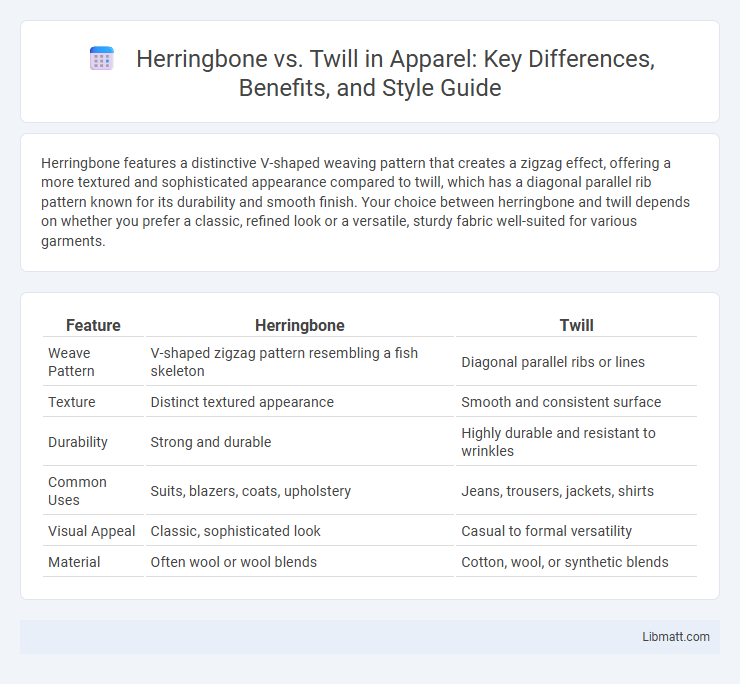Herringbone features a distinctive V-shaped weaving pattern that creates a zigzag effect, offering a more textured and sophisticated appearance compared to twill, which has a diagonal parallel rib pattern known for its durability and smooth finish. Your choice between herringbone and twill depends on whether you prefer a classic, refined look or a versatile, sturdy fabric well-suited for various garments.
Table of Comparison
| Feature | Herringbone | Twill |
|---|---|---|
| Weave Pattern | V-shaped zigzag pattern resembling a fish skeleton | Diagonal parallel ribs or lines |
| Texture | Distinct textured appearance | Smooth and consistent surface |
| Durability | Strong and durable | Highly durable and resistant to wrinkles |
| Common Uses | Suits, blazers, coats, upholstery | Jeans, trousers, jackets, shirts |
| Visual Appeal | Classic, sophisticated look | Casual to formal versatility |
| Material | Often wool or wool blends | Cotton, wool, or synthetic blends |
Introduction to Herringbone and Twill
Herringbone and twill are distinct weaving patterns widely used in textiles and fashion, each characterized by unique diagonal line arrangements. Herringbone features a distinctive V-shaped zigzag pattern created by reversing the twill weave direction at regular intervals, resulting in a broken zigzag effect. Twill, known for its parallel diagonal ribs, produces a durable and textured fabric often used in denim, suits, and upholstery.
Definition and Overview of Herringbone
Herringbone is a distinctive V-shaped weaving pattern characterized by its broken zigzag design resembling the skeleton of a herring fish, commonly used in textiles and flooring. This pattern differs from twill, which features a diagonal parallel weave creating a continuous line without the zigzag break. Herringbone's unique structure offers enhanced visual texture and durability, making it popular in suiting fabrics and parquet flooring.
Definition and Overview of Twill
Twill is a textile weave characterized by its diagonal parallel ribs, created by passing the weft thread over one or more warp threads and then under two or more warp threads in a regular pattern. This weave offers durability and drape, commonly used in denim, chino fabrics, and suits due to its distinct texture and resistance to wrinkles. Your choice between herringbone and twill depends on whether you prefer the zigzag pattern of herringbone or the smooth diagonal lines of traditional twill.
Key Differences Between Herringbone and Twill
Herringbone features a distinctive V-shaped weaving pattern created by alternating diagonal lines, while twill is characterized by parallel diagonal ribs running consistently in one direction. Herringbone patterns often appear as broken zigzags, offering a textured, more complex visual effect, whereas twill provides a smoother, uniform surface with better drape and durability. These structural differences influence the fabric's appearance, feel, and typical applications in fashion and upholstery.
Weaving Techniques: Herringbone vs Twill
Herringbone and twill are distinctive weaving techniques, with herringbone featuring a broken zigzag pattern formed by reversing the direction of the twill weave at regular intervals. Twill weave creates a diagonal rib pattern through a consistent over-under thread sequence, resulting in durable and flexible fabric. Your choice between herringbone and twill impacts the texture, visual appeal, and structural integrity of the fabric in fashion or upholstery applications.
Visual Appearance and Texture Comparison
Herringbone features a distinctive V-shaped weaving pattern that creates a zigzag effect, offering a more intricate and dynamic visual appearance compared to twill's diagonal parallel lines. The texture of herringbone is slightly more pronounced and tactile due to the alternating direction of the weave, providing a richer, more textured feel underhand. Twill's smoother, consistent weave results in a softer texture and a subtler, more uniform visual appeal.
Durability and Performance Analysis
Herringbone and twill fabrics both offer notable durability due to their tightly woven diagonal patterns, but twill typically exhibits higher abrasion resistance, making it ideal for heavy-use applications. Herringbone's distinct zigzag weave provides enhanced wrinkle resistance and maintains structural integrity under frequent wear, contributing to long-term performance. Performance-wise, twill allows better drape and flexibility, while herringbone delivers a firmer texture and superior dimensional stability in upholstery and outerwear.
Applications in Fashion and Interior Design
Herringbone and twill patterns are widely used in fashion and interior design for their textured, visually appealing zigzag and diagonal lines. Herringbone is favored in suits, coats, and upholstery due to its distinctive V-shaped weave that adds sophistication and depth, while twill's diagonal rib pattern is popular in denim, trousers, and curtains for durability and subtle texture. Both patterns offer versatile aesthetics, with herringbone delivering a classic, refined look and twill providing a more casual, sturdy finish ideal for high-traffic spaces.
Pros and Cons of Herringbone and Twill
Herringbone fabric offers a unique zigzag pattern that enhances visual texture and adds a classic, sophisticated appeal, making it ideal for tailored suits and outerwear, but it can be less versatile and slightly heavier compared to twill. Twill fabric features a diagonal weave that provides durability, wrinkle resistance, and a smooth finish, which is perfect for casual and formal wear, though it may lack the distinctive aesthetic flair of herringbone. Your choice depends on whether you prioritize the refined, patterned style of herringbone or the practical, sturdy qualities of twill.
Which Weave Is Right for You?
Herringbone and twill weaves both offer durability and distinct texture, with herringbone featuring a zigzag pattern ideal for adding visual interest to your garments, while twill boasts diagonal lines providing a smooth, flexible feel perfect for everyday wear. Your choice depends on whether you prefer the classic sophistication and subtle complexity of herringbone or the timeless, breathable comfort of twill. Consider the intended use and style preferences to determine which weave best complements your wardrobe needs.
Herringbone vs twill Infographic

 libmatt.com
libmatt.com